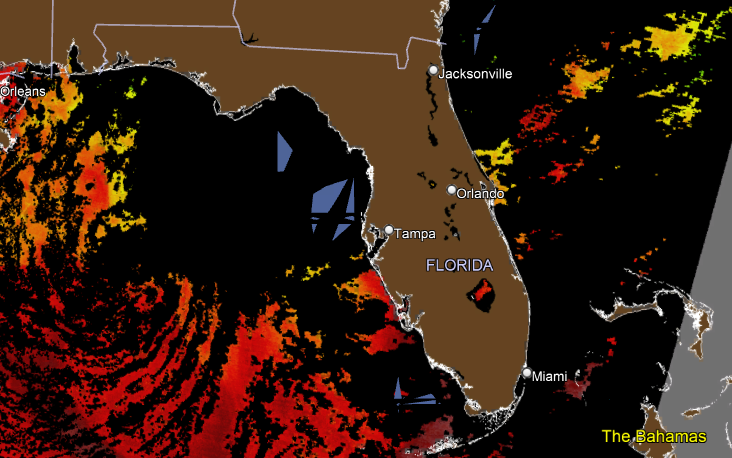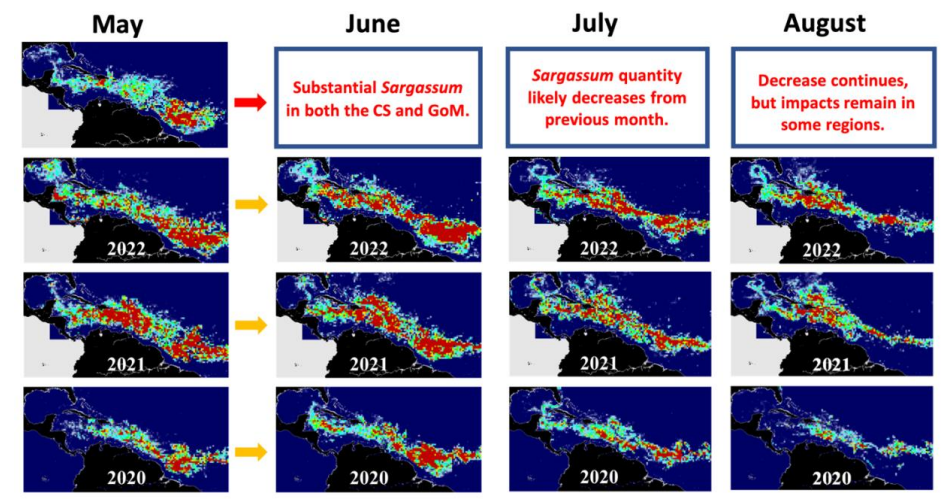'Substantial' sargassum expected in Caribbean, Gulf of Mexico. When, where seaweed will be in June
Substantial sargassum is expected in June in both the Caribbean Sea and Gulf of Mexico, according to the May report from the University of South Florida.
That's no surprise to beachgoers who have been seeing the smelly seaweed on Florida beaches from Pensacola to Brevard County. It's also unwelcome news.
Palm Beach sees smelly seaweed: It's here! Blob of smelly seaweed arrives on Palm Beach
Avoid infection: Vibrio bacteria could be in Florida sargassum seaweed. How to prevent getting an infection
The University of South Florida's Optical Oceanography Laboratory's College of Marine Science maintains a satellite-based Sargassum Watch System.
Here's the latest on where the seaweed is and when it's expected to decline.
How much sargassum is out there?

Overall, the amount of sargassum in the Great Atlantic Sagassum Belt — which extends from the west coast of Africa to the Gulf of Mexico — actually decreased in May by 15 percent from what was observed in April.
"Such a decrease for this time of the year never occurred in history since the first year (2011)" the Sargassum Belt has been monitored.
Can Sargassum get worse? Yes: Sargassum, flesh-eating bacteria and plastic create 'perfect storm,' says Florida study
What to do about Sargassum: Seaweed all over Satellite, Cocoa Beach: What Brevard beaches look like in summer 2023 & what to do
Amounts of the seaweed in the Caribbean Sea decreased slightly.
However, amounts of sargassum in the Central West Atlantic and Gulf of Mexico increased slightly in May.
Where is the sargassum going?
The sargassum accumulations in the western Atlantic continued to move west with prevailing currents and winds.
In the Caribbean, most sargassum was located around the Lesser Antilles and along the southern coasts ofHispanola, Jamaica, Puerto Rico and along the Mexican Caribbean coast.
Sargassum clumps were observed continuously along the Loop Current into the Straits of Florida.
The Loop Current is an area of warm water that travels up from the Caribbean, past the Yucatan Peninsula and into the Gulf of Mexico. It's also known as the Florida current as if flows through the Florida Strait, into the Gulf Stream and heads north up the eastern coast of the U.S., according to NOAA.
Looking further ahead, where can we expect sargassum in Florida and elsewhere?

Sargassum amounts are likely to decrease in June in the Gulf of Mexico, which should be good news to the residents along the Florida Keys and east coast of Florida, according to the University of South Florida researchers.
Elsewhere, because of the unexpected sharp decrease in the eastern Atlantic and the relatively stable amount elsewhere, it is difficult to predict whether sargassum quantity in the individual regions will increase or decrease, although the quantity will still remain to be relatively high as compared to historical values.
Beachgoers around the Caribbean and Gulf of Mexico can expect sargassum to continue coming onshore this month, "although it is difficult to predict exact timing and location for individual beaching events."
What about the seaweed forecast for July and August?
Researchers are predicting sargassum amounts in July are likely to start decreasing from what is expected in June. That decrease is expected to continue even more in August, although impacts could remain in some areas.
See conditions at Florida beaches using these webcams
Planning to spend some time at the beach but want to check out the latest conditions? Here are several webcams around the state.
Beach webcams: Florida beach live webcams show surf, waves, sargassum seaweed conditions
What exactly is sargassum?
Sargassum is a brown seaweed that floats in the ocean and currently is washing up on many Florida beaches in large amounts.
Is sargassum dangerous for people?
On land, sargassum begins to rot and produces hydrogen sulfide and ammonia.
Hydrogen sulfide can irritate the eyes, nose and throat. If you have asthma or other breathing illnesses, you will be more sensitive to hydrogen sulfide. You may have trouble breathing after you inhale it, according to the Florida Department of Health.
Tiny organisms that live in seaweed, such as jellyfish larvae, may irritate the skin if you come into contact with it.
Can you cook or eat the seaweed?
No. The Florida Department of Health warned the seaweed could contain large amounts of such heavy metals as arsenic and cadmium.
Read the full May sargassum report
If you can't see the report, click on this link.
This article originally appeared on Florida Today: Sargassum snapshot: Where is the seaweed and how bad is it in Florida?

